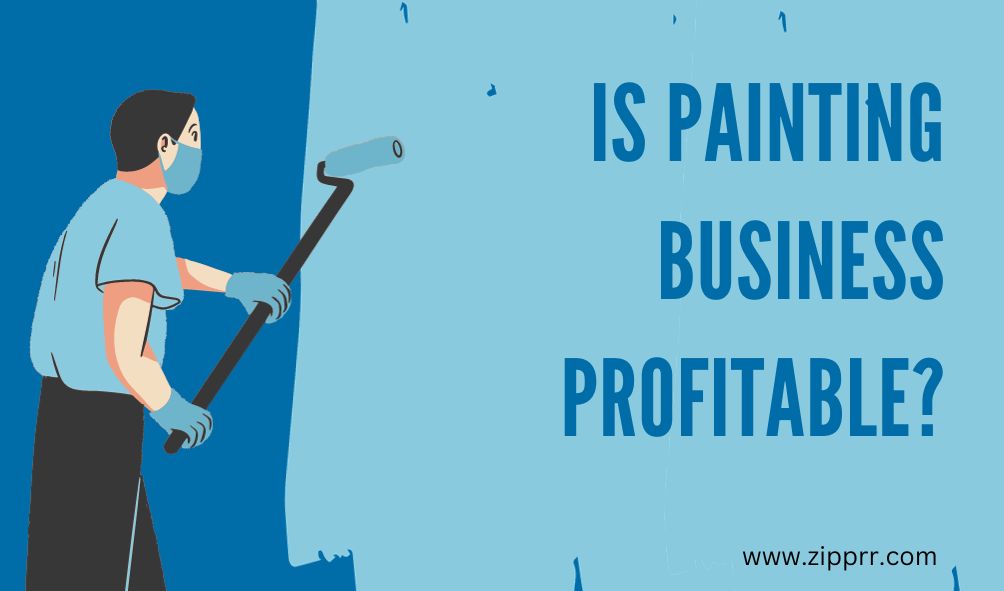Many people think about starting their own painting business. It can be a great way to be your own boss. Others wonder if it really makes good money. The truth is, painting businesses can indeed be lucrative if done correctly. With some hard work and hustle, you can certainly profit from painting homes and commercial spaces. Let’s explore further if painting can be a profitable business venture.
Table of Contents
- What Is Painting Business?
- Why Is Painting Business Popular?
- Does Painting Business Still Work?
- The Advantages of Painting Business
- The Challenges of Painting Business
- Is Painting Business Profitable?
- What’s a good profit margin for Painting Business?
- How to Increase Your Painting Business Profits?
- Frequently Asked Questions
- To Wrap It Up

What Is Painting Business?
Painting business refers to a professional service that involves the application of paint or other decorative finishes to various surfaces, such as walls, ceilings, furniture, and exteriors. Skilled painters use their expertise to transform spaces, whether it’s a residential home, commercial building, or even a piece of artwork. The demand for painting services remains constant throughout the year, making it a potentially profitable venture for those with the necessary skills and business acumen.

Why Is Painting Business Popular?
Painting may seem like a simple task, but it holds immense potential for those looking to start a business. In recent years, the painting industry has experienced a surge in popularity, with more individuals and businesses recognizing the value of professional painting services. So, what makes painting businesses so sought after? Let’s dive into the reasons behind their flourishing success.
1. Time-Effective Solution: One of the primary reasons painting businesses are popular is the time they save for their clients. Many individuals and businesses simply don’t have the luxury to dedicate hours or days to painting their own spaces. By hiring professional painters, clients can focus on their core responsibilities while the experts swiftly transform their spaces, delivering high-quality results efficiently.
2. Expertise and Skill: Painting may appear effortless, but achieving flawless walls, intricate designs, or custom finishes requires expertise and skill. Professional painters boast years of experience and extensive knowledge of color combinations, techniques, and the latest trends. Their trained eye can provide valuable suggestions, ensuring that the client’s vision is translated into a stunning reality.
3. Quality Assurance: When it comes to painting, quality is paramount. Amateur DIY attempts often result in uneven coats, smudges, or imperfect finishes that are easily noticeable. Painting businesses offer a guarantee of top-notch quality, using high-grade materials, top-of-the-line tools, and refined techniques to deliver flawless results. This quality assurance not only enhances the aesthetic appeal but also increases the durability of the paint job.
4. Stress-Free Experience: Renovations and improvements can be a stressful endeavor for many individuals. Painting businesses understand this and strive to make the entire process as hassle-free as possible. From providing detailed quotes and efficient project management to ensuring clean and tidy work sites, professional painters prioritize customer satisfaction, leaving their clients with peace of mind and a beautifully transformed space.

Does Painting Business Still Work?
Running a painting business has been a timeless trade that has withstood the test of time. Whether you are an experienced artist or just starting out, there is still ample opportunity to make a profitable living through this rewarding profession. Let’s dive deeper into why the painting business continues to flourish in today’s market.
1. High demand: The need for painting services remains consistent, making it a lucrative field to invest your time and skills in. From residential homes to commercial properties, people are always seeking professional painters to enhance the aesthetics of their spaces. With a steady stream of clients, your painting business can thrive.
2. Expansion possibilities: As a painting business owner, you have the freedom to expand your services beyond just wall painting. You can diversify your offerings to include specialty services such as faux finishes, murals, or even cabinet refinishing. By staying versatile, you can tap into different markets and attract a wider customer base.
3. Personal touch: Customers appreciate the personalized touch that a painting business provides. Unlike generic mass-produced products, a beautifully painted space adds value and character. Whether it’s creating a unique atmosphere or adding a pop of color to a room, your artistic skills will always be in demand.
4. Repeat customers and referrals: Satisfied customers often become loyal clients and spread the word about the excellent services you offer. With positive recommendations and referrals, your painting business can establish a strong reputation in the industry. Building a trusted brand will lead to a consistent flow of work and long-term success.

Advantages of Painting Business
Running a painting business has numerous advantages that make it a highly profitable venture. Here are five key advantages that highlight the potential for success in this industry:
1. High Demand: The demand for professional painters is consistently high as homeowners, businesses, and commercial properties seek to enhance the aesthetic appeal of their spaces. With an ever-growing market, a painting business can enjoy a continuous stream of clients.
2. Lucrative Margins: One of the greatest advantages of a painting business is the opportunity for high-profit margins. As a service-based industry, the costs associated with paint and other materials are relatively low compared to the charges customers are willing to pay for a professional touch. This allows you to maximize your profits and grow your business exponentially.
3. Flexibility: Running a painting business offers you the freedom and flexibility to set your own schedule. Whether you prefer to work during weekdays, evenings, or weekends, you have the autonomy to tailor your working hours to suit your personal needs and lifestyle. This flexibility allows for a better work-life balance and can greatly contribute to your overall job satisfaction.
4. Vast Scope of Services: A painting business is not limited to just painting walls. You can diversify your services to include various niche offerings, such as cabinet refinishing, mural painting, or faux finishes. By expanding your range of services, you can attract a wider customer base and cater to different design preferences, ensuring a steady flow of projects and increased profitability.

Challenges of Painting Business
Running a painting business can be a rewarding venture, but it’s not without its fair share of challenges. While the profitability of such a business varies depending on various factors, there are a few common hurdles that painters often face. Let’s take a closer look at four of these challenges:
1. Fierce Competition: The painting industry is a highly competitive one, with numerous painters and companies vying for the same clients. This makes it crucial to stand out from the crowd and differentiate yourself through exceptional workmanship, excellent customer service, and unique marketing strategies. Building a solid reputation and establishing a loyal customer base can help mitigate the impact of this challenge.
2. Seasonal Fluctuations: Painting, especially exterior work, is heavily influenced by seasonal changes. During colder months, demand for painting services may decline significantly, making it crucial for businesses to carefully manage their cash flow and allocate resources accordingly. Diversifying services, such as offering interior painting or industrial coatings during slower periods, can help maintain a consistent income throughout the year.
3. Material and Labor Costs: The cost of paint, equipment, and materials can fluctuate, affecting the overall profitability of a painting business. Additionally, ensuring skilled and reliable labor can be a significant challenge, as finding experienced painters who align with your work ethics and standards may prove to be time-consuming and expensive. It’s essential to keep a close eye on expenses and continuously seek cost-effective solutions without compromising on quality.
4. Evolving Industry Standards: The painting industry is constantly evolving, with new technologies, techniques, and regulations emerging over time. Staying updated with these changes and adapting your processes and practices accordingly can be demanding, but is crucial for maintaining a competitive edge. Regular training and professional development for yourself and your team can help overcome this challenge, keeping your business ahead of the curve.

Is Painting Business Profitable?
When it comes to the world of business, profitability is a key factor that every aspiring entrepreneur considers. The painting business is no exception to this rule. If you have a passion for colors and a knack for transforming blank canvases into breathtaking works of art, opening your own painting business might be the perfect venture for you. Let’s explore whether this artistic endeavor can be a profitable one.
1. Diverse Clientele
One of the great advantages of diving into the painting business is the potential for a diverse clientele. From homeowners looking to spruce up their living spaces to businesses seeking a fresh, professional look, the demand for painting services is ever-present. This wide range of potential customers allows for a steady stream of work throughout the year and opens up opportunities for growth and expansion.
2. Repeat Business and Referrals
A satisfied customer is worth their weight in gold, and in the painting industry, this sentiment rings true. Happy clients not only become loyal patrons but also serve as excellent sources of referrals. By delivering quality workmanship and a superb customer experience, you’ll increase the likelihood of securing repeat business and garnering positive word-of-mouth recommendations. A strong referral network can significantly boost your profitability, as it brings in new clientele without the need for extensive marketing expenses.
3. Opportunities for Upselling
The art of upselling can be a powerful tool in the painting business. By offering additional services such as color consultations, custom designs, or even faux finishes, you can increase both the value you provide to your customers and your overall profit margin. Upselling not only maximizes your revenue per project but also enhances customer satisfaction, as clients feel they are receiving more personalized attention and tailored solutions.
4. Efficient Cost Management
Ensuring profitability in any business requires effective cost management, and the painting business is no exception. By meticulously planning and tracking your expenses, you can optimize your profit margin. This includes sourcing quality materials at competitive prices, managing labor costs efficiently, and employing smart marketing strategies. Embracing technology, such as project management software or social media advertising, can also help streamline operations and reduce overhead expenses.

What’s a good profit margin for Painting Business?
When it comes to running a painting business, one burning question always lingers in the minds of entrepreneurs – is it profitable? Well, the short answer is yes, but the real question is, how profitable can it be? The profit margin in the painting industry can vary depending on a variety of factors. To shed some light on this topic, let’s dive into what constitutes a good profit margin for a painting business.
1. Operational Costs: The first consideration in determining a good profit margin is understanding your operational costs. These costs include supplies, equipment, labor, marketing, and administrative expenses. To achieve a healthy margin, it is crucial to keep these expenses in check. Negotiating better prices with suppliers, optimizing your workforce efficiency, and exploring cost-effective marketing strategies are all ways to reduce operational costs and increase profitability.
2. Market Factors: Profit margins can also be influenced by market conditions. Factors such as competition, geographic location, and customer demand play a role. Higher competition may lead to lower margins, while operating in areas with higher demand for painting services can yield higher profitability. Researching and staying informed about your target market will give you an edge in determining the right pricing strategy to maximize your profits.
3. Pricing Strategy: Speaking of pricing, it’s essential to strike a balance between affordability for potential customers and profitability for your business. Offering competitive prices without compromising the quality of your work can give you an advantage in the market. By analyzing your costs, understanding the prices of your competitors, and conducting thorough market research, you can set the right pricing strategy to maintain a healthy profit margin.
4. Reputation and Referrals: Lastly, the reputation you build for your painting business can have a significant impact on your profit margin. Satisfied customers often become loyal customers and can contribute to a steady stream of referrals. Building a strong reputation for delivering exceptional quality and customer service can help you charge a premium for your services, thereby increasing your profit margin as well.
In conclusion, the profitability of a painting business is not set in stone. However, by carefully managing operational costs, adapting to market factors, implementing a smart pricing strategy, and focusing on reputation, you can aim for a healthy profit margin. Remember, as with any business, it requires continuous evaluation and adaptation to ensure long-term success.

How to Increase Your Painting Business Profits?
If you are an avid painter and are looking to turn your passion into a profitable business, you might be wondering, “Is a painting business profitable?” The answer is a resounding YES! With a little strategic planning and a few tried-and-true tactics, you can increase your painting business profits and take your venture to new heights.
Here are some insider tips that can help you maximize your profits:
- Target a Niche Market: Instead of trying to cater to everyone, focus on a specific segment of the market. Whether it’s residential or commercial painting, or specializing in unique finishes or restoration, finding your niche will allow you to become an expert and charge a premium for your specialized services.
- Offer Exceptional Customer Service: Going the extra mile for your clients is crucial in building a loyal customer base and generating positive word-of-mouth. Treat each project with the utmost attention and ensure customer satisfaction by providing clear communication, meeting deadlines, and addressing any concerns promptly.
- Build a Strong Online Presence: In today’s digital age, having a professional website and active social media profiles is essential for any business. Showcase your previous work, highlight customer testimonials, and actively engage with your audience to establish yourself as a reputable and reliable painting professional.
However, the key to increasing your painting business profits lies in delivering superior results. Providing top-notch craftsmanship, using high-quality materials, and staying up-to-date with the latest painting techniques will not only set you apart from your competitors but also enable you to command higher prices.
In conclusion, starting a painting business can indeed be profitable if you employ the right strategies. By targeting a niche market, providing exceptional customer service, building a strong online presence, and delivering outstanding results, you can keep your brushes busy and your profits flourishing.
Frequently Asked Questions
How much money can I make?
You can earn anywhere from $30,000-$80,000 per year depending on your experience and how hard you work.
What kind of expenses will I have?
Expect costs for supplies, tools, insurance, marketing and possibly employees. But with good organization, you can keep expenses reasonable.
How do I get customers?
Word of mouth is great. Also advertise on social media, local online listings, and distribute fliers. Provide top quality work so customers refer friends.
Can I do this myself or should I hire help?
You can start solo but may want help as you get busier. Hiring lets you take on larger jobs quicker.
How much should I charge?
Rates vary by area but $15-$40 per hour or square foot is typical. Consider materials, skills and overhead when setting your prices.
How can I get steady work?
Build relationships with property managers, contractors and past customers. Offer discounts for bulk or seasonal work to keep the jobs flowing in.
Is now a good time to start?
Anytime can work if you hustle. But painting needs are usually steady, so don’t wait – start building your client base now!
In Summary
As our colorful exploration of the painting business comes to a close, we leave you with a canvas of insights to ponder upon. Like the brushstrokes of a master artist, the profitability of the painting business dances gracefully on the palette of entrepreneurship. While the creative spirit and undeniable passion fuel this industry, the question of profitability remains open-ended, waiting for a subjective stroke of interpretation.
Much like a carefully constructed masterpiece, the potential profit in the painting business lies in the eye of the beholder. It demands a delicate balance of skill, strategy, and a keen understanding of the ever-changing marketplace. From elegant strokes that effortlessly attract high-end clientele to broader brushstrokes capturing the heart of mass markets – the possibilities are limited only by your imagination.
Yet, amidst the vibrant landscape of opportunity, we must tread cautiously. The painting business, like any other, bears its own set of challenges. Pricing structures, seasonal fluctuations, and fierce competition can cast a shadow on the path to profitability. In this realm of artistry meets entrepreneurship, a steady hand and a discerning eye become crucial tools in the pursuit of success.
As the closing lines of this article fade into the horizon, remember that profitability, in the realm of painting business, is not merely a number on a canvas. It is a nuanced expression of the sum of our efforts, a tapestry woven by dedication, expertise, and an unwavering commitment to excellence.
So, aspiring brush-wielders and seasoned painters alike, take these insights not as definitive answers but as guiding strokes on the canvas of your own painterly journey. As the beauty of this creative industry unfolds, may your palette be forever filled with bright hues of innovation, your brushstrokes be confidently bold, and your final masterpiece be a testament to the profitability that can be achieved within the world of painting.







